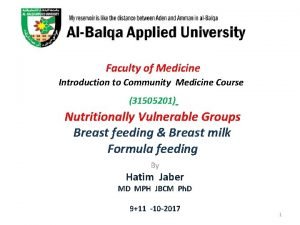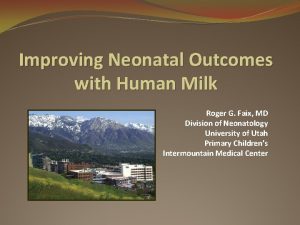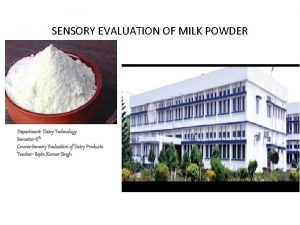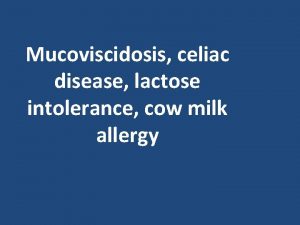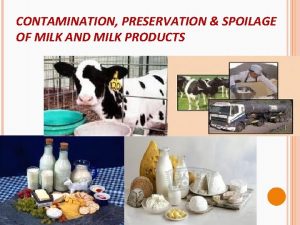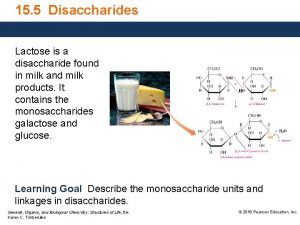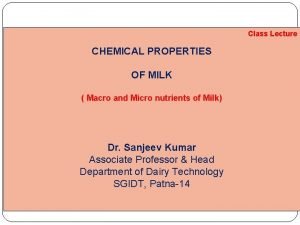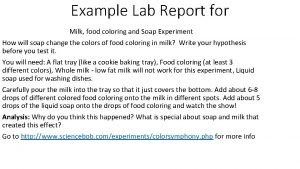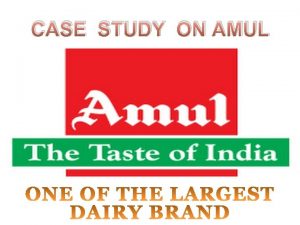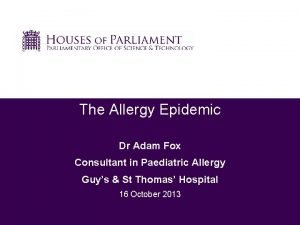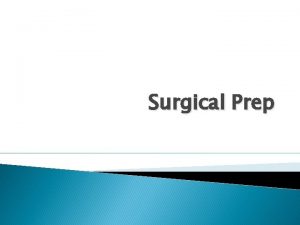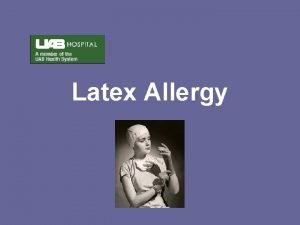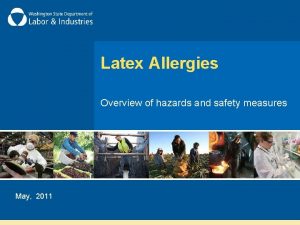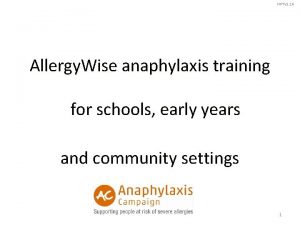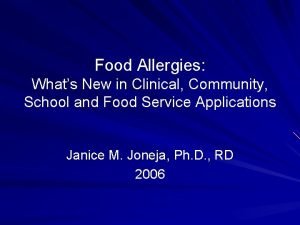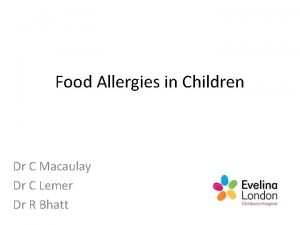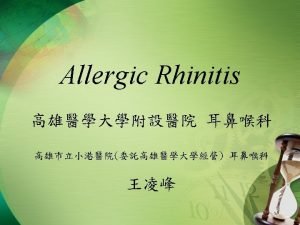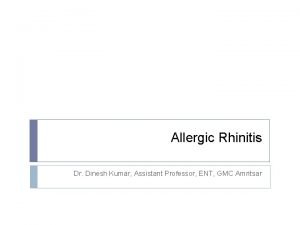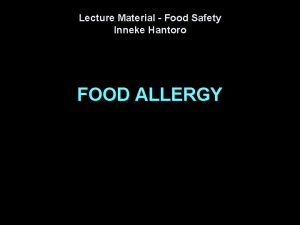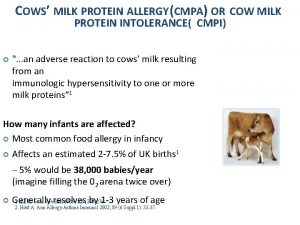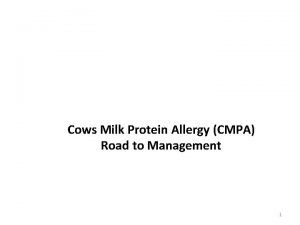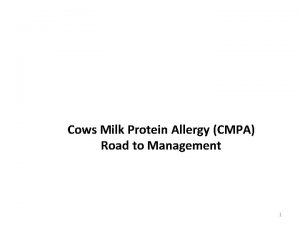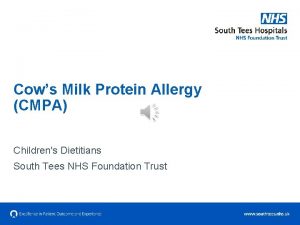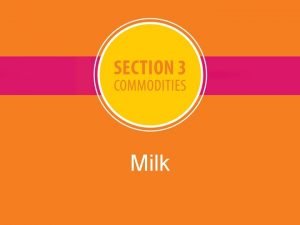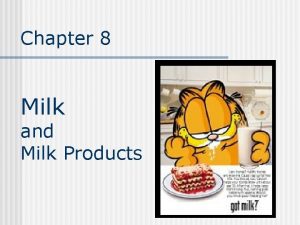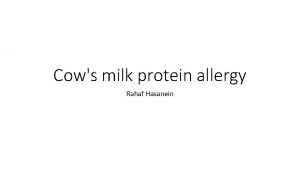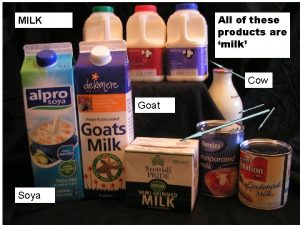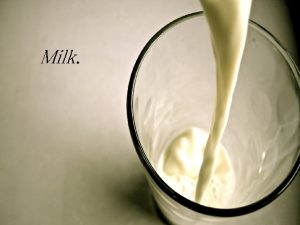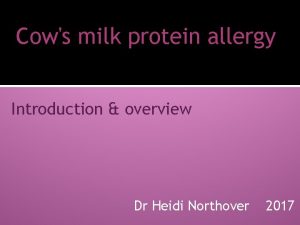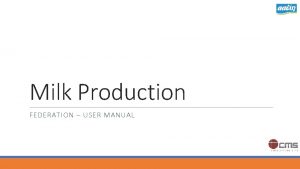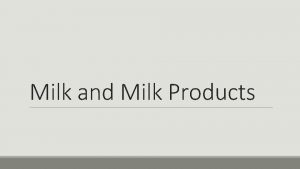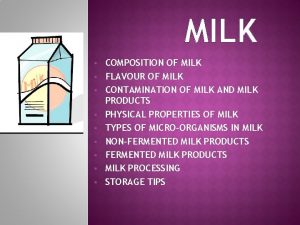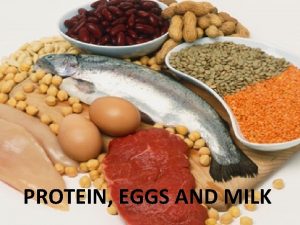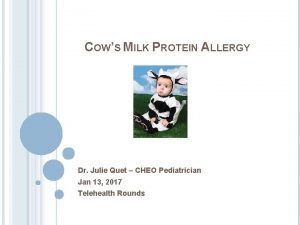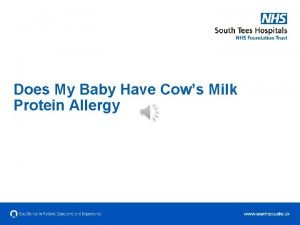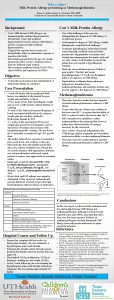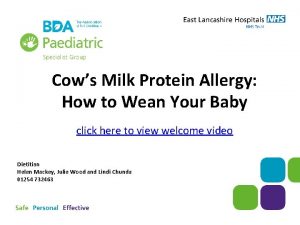CASE REPORT COW MILK PROTEIN ALLERGY CMPA INTRODUCTION
























- Slides: 24


CASE REPORT COW MILK PROTEIN ALLERGY (CMPA)

INTRODUCTION • The occurrence of cow milk protein allergy (CMPA) has been recognized in India. • Overall the incidence of CMPA in the infants fed with formula milk is 5 -7% and in breastfed infants is 0. 5 -1%. Sambrook J. Incidence of cow’s milk protein allergy. Br J Gen Pract. 2016 Oct; 66(651) : 512 • β-lactoglobulin in cow's milk is responsible for the allergy • Though the incidence is less in breastfed infants and early presentation is rare here in this case report we present a case of CMPA associated with exclusive breastfeeding.

CASE • Exclusively breastfed 3 months old female baby presented with complaints of streaks of blood in stool. The infant had one episode of blood streak in stool at 2 months of age. • The baby was brought for neonatal consultation when episode of blood streak in stool increased to 4 times in a week. The baby was otherwise well.

BIRTH HISTORY • The baby is 2 nd child of non-consanguineous Indian couple. The mother had history of hypothyroidism and gestational diabetes managed by Eltroxin and diet control respectively. • The baby was delivered by LSCS at 38+4 weeks with birth weight of 2. 91 kg. • The Apgar score was 8 and 9 at 1 and 5 min respectively. Formula feed was initiated after an hour of life and breast feeding was started at 15 hours of life.

BIRTH HISTORY CONTD……. • On day 5, thyroid profile was performed and was normal. • The baby was discharged on day 7 th Day and advised vitamin D 3 drops 400 IU/ day. • At the time of discharge, the transcutaneous bilirubin was 10, the baby was alert and active, maintaining temperature, hemodynamically stable with no congenital malformation. • Age appropriate immunization was given and baby gained 500 gm weight over a period of one month.

PAST HEALTH HISTORY • At one month of age baby developed jaundice with serum bilirubin of 13. 2 mg, mild abdominal distention and passage of flatus. • G 6 PD enzyme was normal. • Breast milk associated jaundice was suspected and the mother was advised to continue breastfeed well. Gradually over 2 weeks the TSB was in normal range.






DIAGNOSIS • Stool examination • Revealed reddish yellow ill formed Alkaline reaction with traces of mucus and blood, pus cells 12 -15, RBC- 10 -12/HPF, no cyst/ova, and occult blood- +ve. • Eosinophils count: Eosinophil count was 3 Cells/cmm. Significant increase in eosinophils was noted. • Colonoscopy • Revealed loss of vascular pattern and nodularity + throughout. Biopsy finding revealed intact colonic lining epithelium. Lamina propria shows focal congestion, moderate lymphoplasmacytic cells infiltrate with occasional eosinophils, bits of colonic mucosa with surface inflammatory cell exudate.

MANAGEMENT AND COURSE OF ILLNESS • Injection vitamin K 1 mg. was given. • As the episodes of blood streaks in stool increased, mother was initially advised to stop almonds and eggs. But the symptoms didn’t subside and she was then advised total exclusion of CMP in her diet. • The symptoms however, still persisted and the infant was diagnosed as allergic procto-colitis. • Dietary re-evaluation revealed intake of CMP from sources having hidden content of milk e. g. bread.

MANAGEMENT AND COURSE OF ILLNESS • Mother was again counselled for CMP free diet and breast feed was continued. Multi-vitamins and calcium were added • The episodes of blood streaks in baby’s stools settled. • The baby did not gain sufficient weight and was less active. Therefore, gradually complementary feed was initiated at 5 months of age with semonila halva initially and mashed banana was added after three days. • After three days of this complementary feed the infant developed constipation which was relieved on 10 th. day with glycerine suppository. • Thereafter baby had normal bowel movements.

PRESENTATION AND CLINICAL MANIFESTATION AS PER LITERATURE • Mean age at diagnosis is 17. 2 ± 7. 8 months • Usually weaning infants present with abdominal distension, vomiting, dysentery / bleeding per rectum due to allergic proctitis, proctocolitis and enterocolitis, and rarely with constipation, failure to thrive, and watery diarrhoea • Arunachalam P, Mathai J. Neonatal segmental enteritis due to cow’s milk allergy. J Indian Assoc Pediatr Surg. 2013; 18(4): 149– 51 • In addition to these the neonates may present with refusal to feed, eczema, irritation, shock and renal failure • YQ Teng, JX Yao, W Zhu, X Yan, Qy Lu, J Jin. Clinical Analysis of Cow's Milk Allergy in Eleven Neonates. HK J Paediatr (new series) 2011; 16: 273 -277

DIAGNOSIS AND MANAGEMENT • The immune reaction can be Ig. E or non Ig. E mediated. • In case mother is breast feeding she should be encouraged to avoid all milk and related products from her diet and should continue breast-feeding. • Mothers should be referred to dietitian for counselling to avoid all hidden sources of CMP.

DIAGNOSIS AND MANAGEMENT • In addition, the child should receive CMP free complementary feedings and drugs. • Initially while confirming the diagnosis mother should be encouraged to take CMP free diet for 14 days and if there is improvement in symptoms she should continue to avoid CMP.

DIAGNOSIS AND MANAGEMENT • In case no improvement , the infant should be evaluated for other cause and treated accordingly. • If symptoms improve CMP can be reintroduced to mothers diet. • In case this challenge is positive mother can continue to breast feed on CMP free diet and calcium 1000 mg/day can be added to her diet. • In case the infant has persistence of signs and symptoms on breastfeed of mother on CMP free diet other substances such as egg or soy allergy can be suspected and mother has to eliminate such products from diet in order to continue breastfeeding.

DIAGNOSIS AND MANAGEMENT • In case infant is not breastfed, all products containing CMP and animal products should be stopped. • Extensively hydrolysed infant formula is started and in infants with severe allergy amino acid based formula can be used. • After 6 months of age if tolerated Soya milk protein can be an option. In addition to this nutritional counselling and regular monitoring of growth and development is mandatory. • Undue and overt elimination should be avoided as majority( >90%) develop tolerance by 6 years of age, 75% develop by 3 years of age, henceforth it is essential to evaluate the child for tolerance of milk every 6 -12 months.

AT HOME DIAGNOSIS • Open cow milk challenge test period is of one week and it is used for diagnosis of CMA at home. • The milk intake is initiated at 0. 5 ml to 20 ml on day one, then increase to 90 ml on second day and the end of the week it is increased up to full feed. This challenge is repeated at eighth day and after four weeks. If no symptom appear intake of normal amounts can be initiated and we can continue to reassess the infant.

CONCLUSION • In conclusion, we share our experience of managing a case of allergic procto-colitis due to CMPA in an exclusively breast fed neonate. It is important to remember hidden sources of CMP intake while modifying maternal diet.

REFERENCES • 1. Poddar U, Yachha SK, Krishnani N, Srivastava A. Cow’s milk protein allergy: an entity for recognition in developing countries. J Gastroenterol Hepatol. 2010 Jan; 25(1): 178– 82. • 2. Sambrook J. Incidence of cow’s milk protein allergy. Br J Gen Pract. 2016 Oct; 66(651): 512. • 3. Arunachalam P, Mathai J. Neonatal segmental enteritis due to cow’s milk allergy. J Indian Assoc Pediatr Surg. 2013; 18(4): 149– 51. • 4. YQ Teng, JX Yao, W Zhu, X Yan, Qy Lu, J Jin. Clinical Analysis of Cow's Milk Allergy in Eleven Neonates. HK J Paediatr (new series) 2011; 16: 273 -277 [Internet]. [cited 2018 Apr 3]. Available from: https: //pdfs. semanticscholar. org/4 b 8 e/32 ab 8 c 6 bed 114 f 5 e 50578 b 115 ffb 6 bc 5077 d. pdf • 5. Brill H. Approach to milk protein allergy in infants. Can Fam Physician. 2008 Sep; 54(9): 1258– 64. • 6. Koletzko S, Niggemann B, Arato A, Dias JA, Heuschkel R, Husby S etal. Diagnostic Approach and Management of Cows Milk. [Internet]. [cited 2018 Apr 3]. Available from: http: //www. espghan. org/fileadmin/user_upload/guidelines_pdf/Diagnostic_Approach_and_Management_of_ Cow_s_Milk. 28. pdf

 Human milk vs cow milk
Human milk vs cow milk Difference between human milk and cow milk
Difference between human milk and cow milk Sensory evaluation of milk and milk products
Sensory evaluation of milk and milk products Milk for toddlers with milk allergynon dairy
Milk for toddlers with milk allergynon dairy Contamination of milk and milk products
Contamination of milk and milk products A disaccharide found in milk and milk products
A disaccharide found in milk and milk products Buffalo milk contains
Buffalo milk contains Channel vs carrier proteins
Channel vs carrier proteins Protein-protein docking
Protein-protein docking Best case worst case average case
Best case worst case average case Milk and food coloring lab report
Milk and food coloring lab report 7 steps of critical thinking
7 steps of critical thinking Amul case study
Amul case study Dr fox allergy
Dr fox allergy Surgical prep guidelines
Surgical prep guidelines Latex allergy rash pictures
Latex allergy rash pictures Latex fruit allergy
Latex fruit allergy Allergy wise
Allergy wise Nursing supervisors are selected using random numbers
Nursing supervisors are selected using random numbers Oas symptoms
Oas symptoms Macaulay allergy
Macaulay allergy Allergy shiners
Allergy shiners Transverse nasal crease removal cream
Transverse nasal crease removal cream Allergic rhinitis treatment guidelines
Allergic rhinitis treatment guidelines Allergy
Allergy
